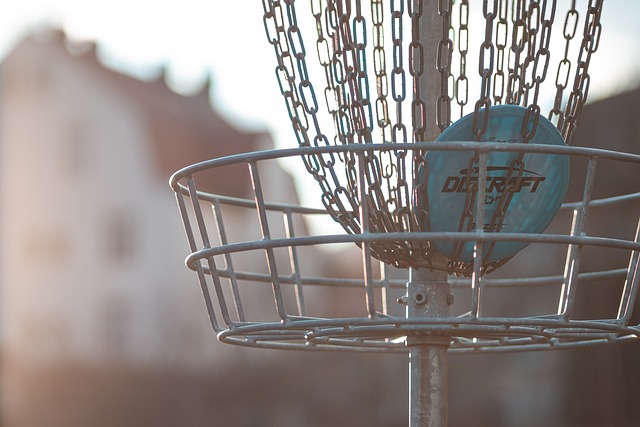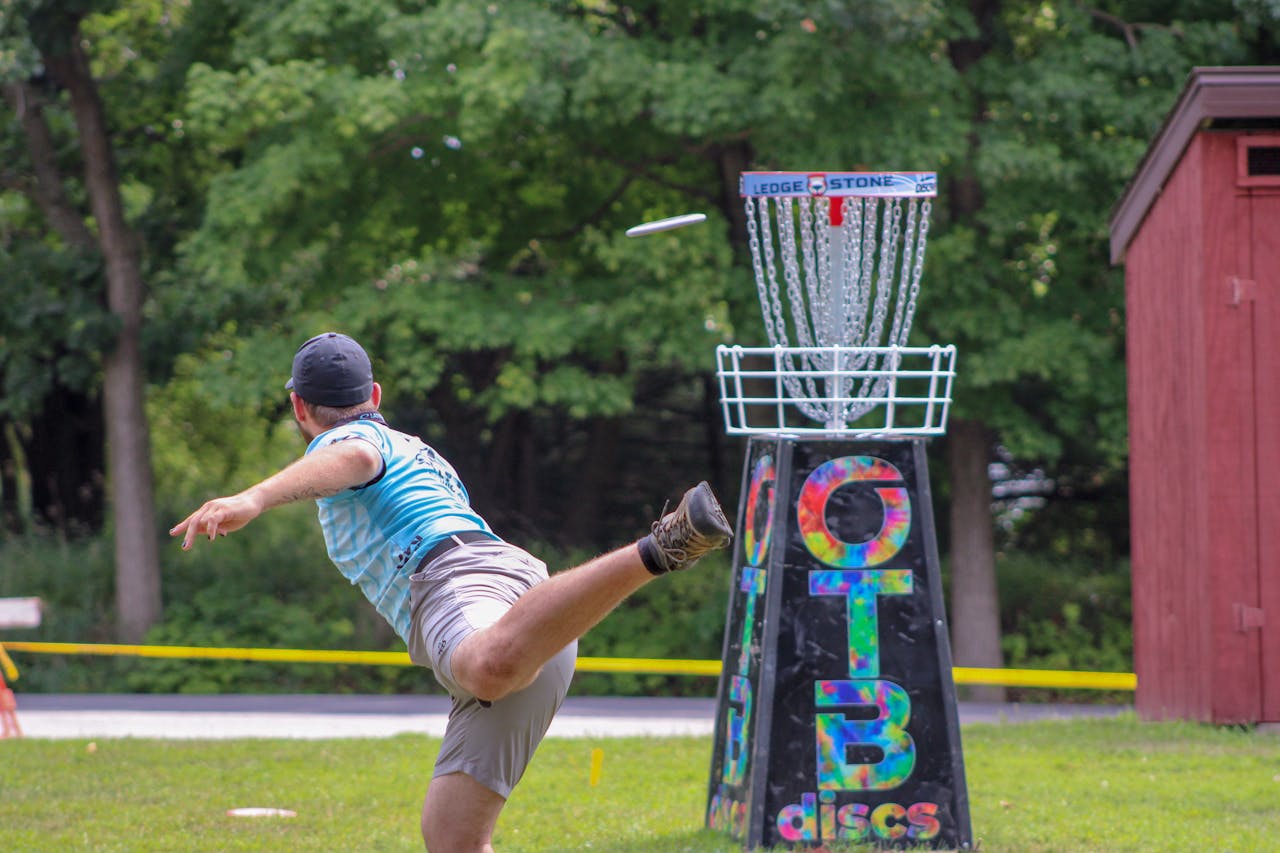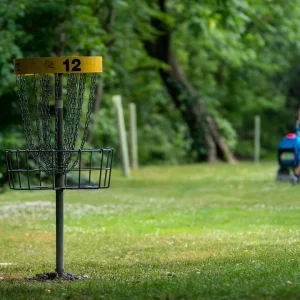Contents
Ever wondered how to combine the precision of golf with the fun of frisbee? Welcome to the world of Disc Golf! It’s an adrenaline-pumping sport that’s rapidly gaining popularity, and we talked to experts from Prodigy Disc to guide you through the basics.
Understanding the Basics of Disc Golf
Disc Golf – a thrilling yet strategic sport – is already familiar to you. By merging the joy of a frisbee’s throw with attention to detail typical of golf, it’s created a unique game indeed. Now, let’s delve deeper into it, layout the basics and uncover the rich history behind it.
What Is Disc Golf?
As a sport, it fuses the fun dynamics of throwing a flying disc, much like a frisbee, and the classic rules of golf. Players toss discs toward a target, often known as a hole, across diverse terrain while aiming to complete the course in the fewest number of tosses. Various types of discs exist for different scenarios. Just like in golf where you’d use a driver for long-distance shots and a putter for short ones, in Disc Golf, you’d have a ‘Distance Driver’ for long throws and a ‘Putter’ for cloaking into the hole.
History and Popularity of the Sport
From its humble inception, disc golf has seen ample growth in its popularity. The spark came back in the ’60s when Edward Headrick, fondly known as the father of Disc Golf, formalized the rules and made it an organized sport. From then on, it’s only been an upward journey. Fly back to 1965, when there were mere few disc golf courses, fast forward to the present day, the Professional Disc Golf Association (PDGA) cites more than 4,000 official courses globally. That’s not random growth, it’s an explosive one, and it’s largely due to its easy accessibility. Whether you’re an athlete or a rookie, it’s got a place for everyone – a key reason for its surging popularity.

Equipment Needed for Disc Golf
In this exciting sport, the gear you choose plays a significant role in your overall performance. With the right equipment in hand, no course is too challenging, and no throw too tricky. Let’s dive into what you require to play Disc Golf.
Types of Discs and Their Uses
Three types of discs often find their place in a player’s Disc Golf bag – the Driver, the Mid- Range, and the Putter.
- Drivers, the thickest discs, come in handy for long-distance throws. Their sharp edges provide aerodynamic support, enabling the discs to travel great distances.
- Mid-Range discs, with their slightly rounded edges and thinner profiles, allow for more control over the throw. Perfect for covering shorter distances, these discs offer a balance between distance and accuracy.
- Putters, the thickest, deliver maximum control and accuracy while throwing. These discs, with their rounded edges and flat top, are used for shorter throws, especially those in the vicinity of the target.
Essential Gear for Every Player
Disc Golf, notwithstanding its adventurous streak and outdoor nature, doesn’t necessitate a plethora of equipment. Besides an assortment of discs, here’s what you’ll likely need:
- Disc Golf Bag – It’s crucial to carry a sturdy and durable bag to store and transport your discs. Options range from standard backpacks to specialized Disc Golf bags designed with compartments for each type of disc.
- Comfortable Clothing – Opt for clothes that breathe and are flexible, as swing mechanics in Disc Golf involve intense arm and body movements. Invest in pair of quick-dry and dirt-resistant pants or shorts, along with a moisture-wicking shirt.
- Athletic Shoes – Shoes with good traction are essential, given the diverse terrains involved in Disc Golf courses. Water-resistant options are a good bet.
- Sports Sunglasses – A pair of UV-protected sunglasses can help protect your eyes and improve visibility on sunny days.
- Disc Golf Towel – Ideal for wiping off dirt and moisture from your discs and hands, it’s an often overlooked but important piece of gear.
- Scorecard and Pencil – Though technology has introduced digital scoring options, having a backup scorecard is always a good idea.
By investing in the right set of tools and equipment for Disc Golf, you’re one step closer to becoming a seasoned player in this exhilarating sport.
Basic Rules of Disc Golf
Retaining the directive angle we’ve established, we delve into the cornerstone of Disc Golf—its rules. Disc Golf, similar to its traditional namesake, beholds a fundamental set of regulations players must adhere to. This section unravels these regulations, focusing on scoring, objectives, common penalties, and preventative measures.
Scoring and Objectives
In Disc Golf, the principle objective remains uncomplicated—throw the disc from the tee area and aspire to have it land in the basket, known as the ‘Disc Pole Hole’, in the fewest attempts possible. Every throw constitutes a stroke, signifying that a lower total score translates into a superior performance. Determining a score becomes straightforward—simply tally the total number of throws taken on each hole. In essence, the fewer the throws, the better the score.
Common Penalties
With any sport, certain actions result in penalties. In Disc Golf, a one-stroke penalty is instigated when a disc lands out-of-bounds (OB), or moves beyond the designated playing area. To clarify established OB lines, they’re typically outlined by roads, fences, water, or marked ropes.
How to Avoid Them
Sidestepping penalties requires a keen grasp of course layout, a concentration on precision over power, and an intuitive understanding of wind patterns and disc flight characteristics. For instance, to avoid the notorious OB penalty, instead of attempting a daring flight across a lake, a strategic throw alongside its edge is advisable. Understanding your disc and the way it moves can drastically reduce the occurrence of penalties.
We now segue into the subsequent section—Strategies for Playing Disc Golf. Armed with the foundational knowledge of the rules, we further elaborate on how to tactically approach, navigate, and outmaneuver the terrain of a Disc Golf course.
How to Play Disc Golf: Step-by-Step Guide
Now that we have a solid understanding of the basics of Disc Golf, we move on to the next crucial aspect – How to Play the game. In this step by-step guide, we lay out two crucial factors in playing Disc Golf: selecting the suitable disc and mastering various throwing techniques.

Choosing the Right Disc
In Disc Golf, not every disc functions the same way. There are three main categories of discs: drivers, mid-range discs, and putters. Drivers, best for long-range shots, have a sharp, pointed edge, leading to more significant distance but harder control. Mid-range discs, on the other hand, straddle the middle ground between distance and control. Lastly, putters, with rounded edges and slower speed, offer maximum control, especially for close shots towards the basket.
Choosing a proper disc can sometimes feel overwhelming, with considerations like speed, glide, turn, and fade to account for. However, for beginners, it’s typically best to start with mid-range discs or putters. These offer an excellent balance between control and distance, and they can help newcomers get a grip on the basics before moving on to drivers, which require more skill to handle.
Referencing the Discraft’s flight rating system, a popular resource among players, might be valuable here. It assigns numeric values to each disc type in terms of their speed, glide, turn, and fade, providing a comparative perspective for players.
Mastering Different Throwing Techniques
Several throwing techniques exist in Disc Golf, each with its specific purpose and advantage. Some of the popular ones include the Backhand, Forehand (or Sidearm), and the Thumber throw.
- Backhand: This traditional throw, similar to the technique used in frisbee throw, allows maximum distance when performed correctly. It involves crossing your body with the disc, then swinging it out and releasing towards the target. It’s also the most comfortable throwing style for beginners to start with.
- Forehand or Sidearm: This technique involves the disc’s flick release at the side of the body. It offers an excellent tool for navigating around obstacles on the course.
- Thumber throw: This overhand throw, gripped with thumb within the rim and fingers on top, produces a unique flight path ideal for overcoming tricky courses.
Advanced Playing Techniques
In extending our discussion on Disc Golf, we now delve into the advanced playing techniques that can elevate your game. Tailoring strategies for different course layouts and implementing certain tips can drastically improve the gameplay.
Strategies for Different Course Layouts
Mastering Disc Golf requires not only strong throwing techniques but also stratagem customization for varying course layouts. Each course, replete with its unique characteristics, poses a different challenge. For instance, narrow courses laden with trees demand precision throwing skill. On the other tree-less but long courses emphasize disc distance travel. Similarly, hilly and wind-swept courses require mastering throws that account for altered disc path caused by shifts in elevation or wind direction.
A strategic approach could involve choosing a specific disc, like the Innova Champion Leopard3 for tight, wooded courses due to its superior control, or opting for the Discraft Buzzz in open, windy settings due to its stability.
Tips to Improve Your Game
Reiteration leads to improvement, but to make the most of your Disc Golf experience, several specific tips come highly recommended. Firstly, regularly practice your throwing accuracy. Working both on your dominant and non-dominant hand throws can bring balance to your overall performance.
Secondly, focus on tweaking your throwing techniques concerning the actual game scenario. For example, while the Backhand throw works best for longer throws, alternating it with the Thumber throw for those tricky over-the-top shots can make all the difference.
Thirdly, develop your putting technique. As closing shots play a significant role in scoring, honing your putting skills using a stable disc, like the Dynamic Discs Judge, can highly benefit your game.
Lastly, ensure physical and mental fitness. Being physically fit allows for consistent throwing power, while maintaining mental calm ensures focused gameplay.
Remember, each game holds a lesson, so perpetually learn and modify your techniques and strategies to improve your Disc Golf gameplay.
We’ve journeyed through the exciting world of Disc Golf, from understanding its basics to mastering advanced techniques. Picking the right disc and honing your throwing skills can significantly improve your game. Remember, starting with mid-range discs or putters is often the best strategy for beginners.
As you progress, adapt your throws and strategies to the unique challenges each course presents. Whether it’s a narrow, tree laden course requiring precision or a long, tree-less one demanding distance, your ability to adjust is key.
References:
- https://www.pexels.com/photo/man-playing-frisbee-golf-13189540/
- https://pixabay.com/photos/disc-golf-frisbee-golf-frisbee-7360499/
- https://pixabay.com/photos/disc-golf-sport-basket-7033786/



